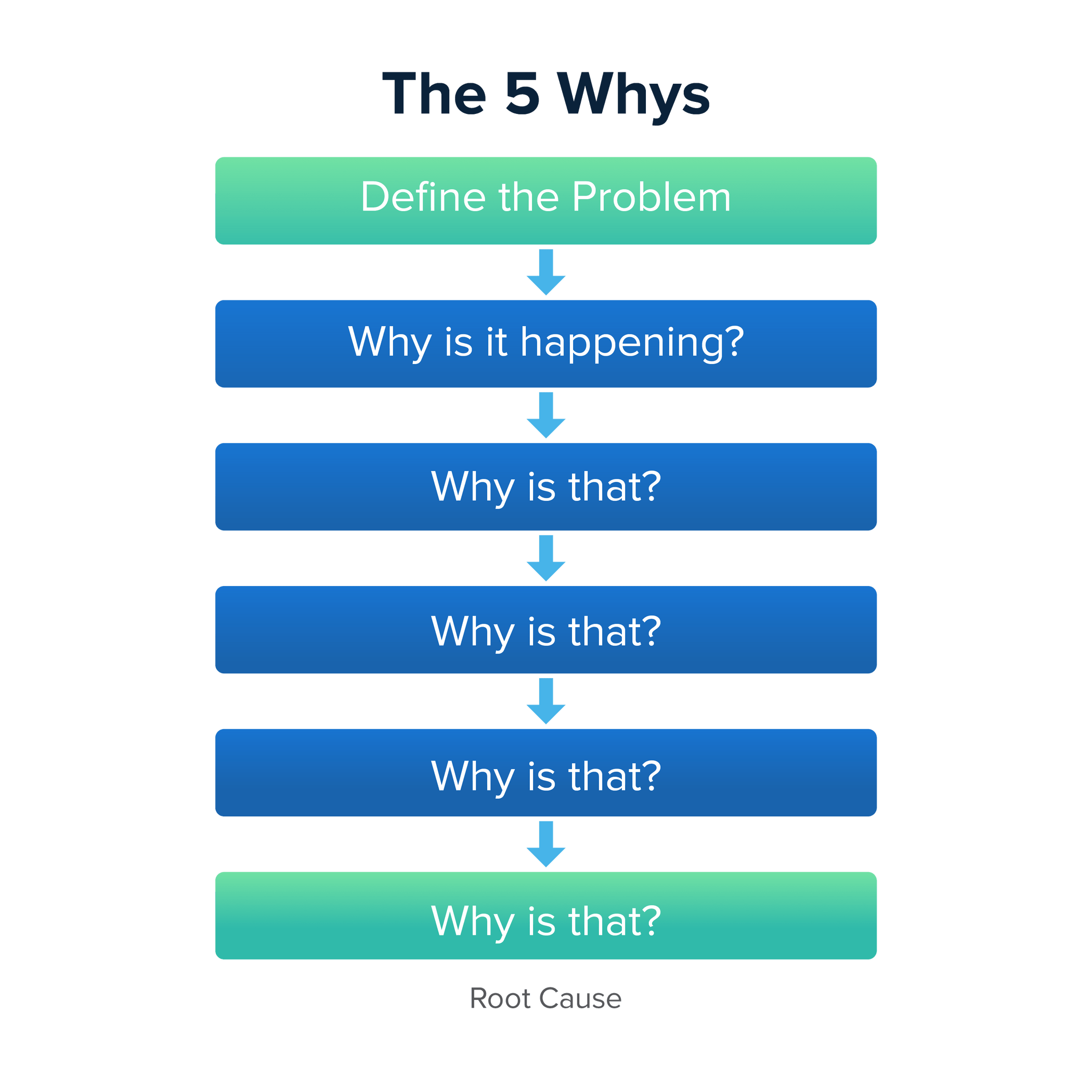How you can use “5 Whys” to understand
the root cause of any problem
We humans are a curious bunch.
We’re so curious, in fact, that we all go through what child psychologists call “the why phase”. It’s only natural to ask questions about the world around us. And even as adults, being able to ask ‘why’ can still be a powerful tool — especially in product design.
So, whether you’re a product owner, innovation manager, or simply someone who wants to know how to solve (almost) any problem, we’d like to introduce you to the 5 Whys technique.
Deceptively simple, yet incredibly effective, the 5 Whys template has been helping people solve complex problems for almost a century.
Now let’s find out how it could help you, too.

5 Whys: a brief introduction (and the power it has)
Problems are a bit like onions — they’re layered.
Depending on the scale of the problem you face, there could be multiple root causes. And to resolve the overall challenge, you need to identify each of these causes in order. Then, as you start to peel back the layers, you’ll eventually make your way to the crux of the issue — and it’s here that real resolution can begin.
So how does the 5 Whys get you there, exactly?
We’ll give you a play-by-play of how to do the exercise shortly. But, essentially, the 5 Whys technique is a problem-solving tool that challenges teams to identify a root cause by asking the question ‘why?’ five times (ideally).
Sounds simple, right? And it is — once you know how to use it.
The most important thing to understand is that business problems are almost always multifaceted — they aren’t caused by just one thing. Issues are often a chain of interrelated problems, adding up to a big one — like the layers of the onion we mentioned earlier. The 5 Whys gives you a fast and effective way of identifying what’s happening under the surface — taking your questioning a layer deeper, with each ‘why’ you ask .
And, if all goes to plan, this technique helps you discover a more permanent solution, too.

Who came up with 5 Whys?
As a design thinking technique, 5 Whys has a somewhat surprising origin — hailing from 1930s Japan, and an industrialist by the name of Sakichi Toyoda, the founder of Toyota.
Almost 100 years on, Sakichi’s 5 Whys method is still used by Toyota today, along with many other global businesses across all industries and verticals. This versatility makes 5 Whys a very valuable tool — and you may have seen it used alongside larger-scale problem solving methods like six sigma DMAIC, but that’s a ‘how-to’ guide for another time.
For now, let’s take a closer look at exactly where, and when, 5 Whys could help your product design team.
When your team should use the 5 Whys technique
You don’t need us to tell you how varied a product design team’s problems can be — covering everything from show-stopping bugs to performance issues, to product/market fit and lack of SMART goals. And because design problems are often — you guessed it! — multi-layered, the 5 Whys is the perfect exercise for design thinking teams to learn.
Especially if:
- You’re always dealing with recurring problems. If you’ve ever had a bug or issue that you just couldn’t squish, you may have eventually discovered that what you thought was causing it, wasn’t doing so at all. In cases of recurring problems in digital products, the 5 Whys methodology can really come into its own — revealing potential solutions, beyond what your team’s considered so far.
- You’re working with technology and human processes together. How do you know when an issue is the fault of the technology or the fault of human error? Very often, it’s impossible to tell — at least on the surface. The 5 Whys technique can help to drill down into a problem’s root cause, so that the trigger is attributed to the correct party, and the solution directed to the right place.
Better still, the 5 Whys technique allows you to properly categorize the problem you’re facing — and take this learning forward to avoid similar problems in the future.
For example, you might think that a technical issue is the fault of a hardware or software system. But after using the 5 Whys technique, you could well discover that it’s really an issue of staff education or a convoluted internal process.
(We’ll look at a very clear example of exactly this issue shortly, so stay tuned.)
Before we move on though, a brief word of warning: while 5 Whys is a great example of problem-solving in action, it’s not the right tool for every issue a business will face. For critical or complex problems, where drilling down through the layers will leave you feeling more lost than you were before, you’re best to take a different route.
If you start off on a line of enquiry, and encounter more questions than answers, you should stop and reconsider.
How to use the 5 Whys technique, in 5 simple steps
Okay, it’s time to get down to the good stuff: a step-by-step of exactly how 5 Whys work in practice.
Step #1: Decide which problem you need to solve — then bring the team together
The 5 Whys is an exercise best done in a team — that way, you’ll benefit from the power of multiple curious minds coming together.
It’s smart to invite the product manager(s), who’s immediately involved with the issue at hand. Likewise, a product owner will be able to provide a birds-eye view of the project — and that can be very useful, too.
Step #2: Summarize your problem in a single sentence
Next, the first action step towards resolution is to properly frame the problem in as simple terms as possible. After all, the 5 Whys works by identifying single root causes, so if you can’t summarize the top-level issue in a single sentence, it might not be the right tool for you.
There’s no need to overcomplicate this step, either — just verbalize the problem, as if you were talking to a friend or family member:
- “The app keeps crashing when users click into this screen”
- “The website is down”
- “Users aren’t clicking through from a specific call-to-action”
All of these are good examples of the types of (seemingly) simple problems that 5 Whys was designed to solve.
Step #3: Ask your first ‘Why?’
Okay, here’s where the magic happens.
It’s time for you, as a team, to ask that one simple question: why? It’s important to note at this point that restraint is an asset for everyone involved. There’s a natural tendency to jump the gun at this stage — to ask ‘Why?’ once and then become side-tracked into the many different potential explanations. But this defeats the purpose.
Instead, it’s a smart idea to ask each member of the team to explain why they think the issue is occurring.
Then you’ll be ready for…
Step #4: Ask as many (or as few) additional ‘Why?’ questions as you need
You guessed it: it’s time to ask ‘Why?’ again.
At this point, you might be wondering exactly what value this technique really has.
Isn’t it a little too simple? Is this really going to uncover something we’ve missed?
… You bet it is!
5 Whys works by stripping the problems back to their very core. So, while it might seem basic to keep asking why, it’s really serving an important purpose by guiding your thought process — and it will pay off.
(If you’re worried about the simplicity of the model, the working example we have to share in the next section should alleviate those worries, so sit tight.)
Finally — and this is key — you should continue to ask why until you feel you’ve hit the root cause of the overall problem. Or, put simply, until you can’t go any deeper. Yes, the name of the technique suggests 5 as a rule of thumb, but you might get there within 2, 3, or even 23 ‘Whys’ — it all depends on the problem.
Step #5: Identify the root problem, then work to solve it
Phew! You’ve made it.
Your team will have mined through the problematic layers and reached the molten core of your problem. You should now be able to clearly identify if it's a technical-, human-, or process-driven issue — and take the appropriate action. With the combined expertise of your product design team, you should have the know-how to work out a real resolution.
One of the most rewarding things about the 5 Whys technique is that, in reality, you’re actually solving more than one problem at once — because any of the ‘whys’ could have become an individual problem for someone else at any point. But with 5 Whys, like a house of cards, you can take out a whole stack of problems in one fell swoop.
Pretty neat, right?
A working example of the 5 Whys technique in action
Okay, so it's all well and good to understand how 5 Whys works on paper, but what about in the real world?
Let’s try an example that any business will understand: your website has gone down.
From here, we can head down through the layers, to identify the root cause. By the end, we’ll have discovered a foundation on which to build a lasting solution to keep the website up and running.
Why #1: Why has the website gone down?
Answer: Because bandwidth has been exceeded after too many users visited.
Why #2: Why did the bandwidth run out?
Answer: Because our hosting plan doesn’t have enough capacity to cover the current volume of users.
Why #3: Why doesn’t our plan have enough capacity?
Answer: Because the website team decided to downgrade our hosting plan at renewal to save money.
Why #4: Why did the website team decide to downgrade the hosting?
Answer: Because the engineering and marketing teams didn’t keep everyone up-to-date on planned product changes — and their intention to bring in more users, causing increased bandwidth consumption.
Why #5: Why didn’t the teams communicate bandwidth capacity requirements before renewal?
Answer: Because there is no established cross-team approval process for IT infrastructure renewals.
And there you have it: we started with a technical problem, which could easily be put down to a poorly performing host, but we ended with a process problem whereby teams weren’t communicating properly.
In just this one simple example, it’s easy to see how — just by peeling back the layers — we can discover the true root cause… and start to deal with the problems in real-time.
Become the master of root cause analysis with this visual 5 Whys template
By this point, you should have everything you need to master the 5 Whys technique, so let’s summarize what we’ve covered with a handy visual.
The following 5 Whys root cause analysis template showcases just how simple (and how powerful) this technique can be for rooting out the cause of practically any problem. And if you want an option to just plug in and play, you can find an editable 5 Whys template here.

Now that you've mastered this powerful technique, create a Free 5 Whys board at EasyRetro!
Ready to work even more effectively as a team?
The 5 Whys is a great way to bring a team of problem-solvers together, and fast-track to the core root of a problem. But how will you reflect on the success of that session — and what will you do to improve it next time?
At EasyRetro, we’ve designed the ideal team-working tool. Work out what went well, what didn’t, and then assign a responsibility to each team member, too. Collaboration’s never been so easy — or so productive.
Find out how EasyRetro could improve your workflow by starting your free 14-day trial today.
